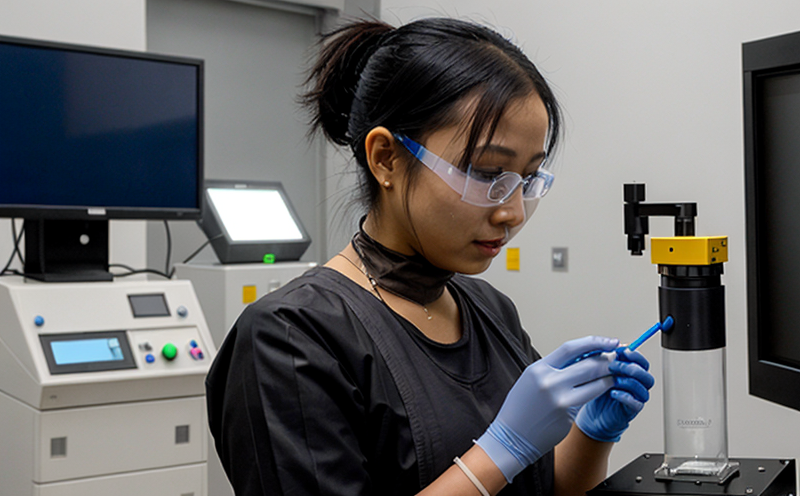ISO 22412 Nanoparticle Size Analysis in Water by Dynamic Light Scattering
The ISO 22412 standard provides a comprehensive framework for the analysis of nanoparticle size distribution in water using dynamic light scattering (DLS) technology. This method is particularly valuable for industries where understanding and managing nanomaterials is critical, such as environmental testing laboratories.
Dynamic Light Scattering (DLS) measures the intensity fluctuations of scattered light from a laser beam that interacts with nanoparticles suspended in a liquid medium. These fluctuations are directly related to the Brownian motion of the particles, which increases with decreasing particle size. By analyzing these fluctuations, DLS allows for precise determination of the size distribution and concentration of nanoparticles within the aqueous solution.
The ISO 22412 standard ensures consistency in nanoparticle characterization by providing detailed protocols on sample preparation, data acquisition, and analysis. It specifies the use of laser sources with a wavelength that is optimal for scattering by nanoparticles in water. The standard also emphasizes the importance of temperature control to minimize thermal effects that could alter particle behavior.
For accurate results, careful sample preparation is essential. This includes ensuring homogeneity of the nanoparticle dispersion and avoiding aggregation or sedimentation during the measurement process. Proper calibration of the DLS instrument using reference particles ensures reliable size distribution data.
The ISO 22412 standard also addresses the issue of particle aggregation by recommending procedures to minimize its impact on measurements. Aggregation can significantly affect the apparent size of nanoparticles, leading to inaccurate results if not properly accounted for. The standard provides guidelines for both preventing and correcting for aggregation effects in data analysis.
Understanding nanoparticle size distribution is crucial for evaluating their environmental behavior. Smaller particles have higher reactivity and greater potential for interaction with biological systems, which can influence toxicity assessments. By adhering to the ISO 22412 standard, laboratories ensure that they are providing accurate and reliable data on particle size distributions in water samples.
Compliance with this international standard is essential for regulatory compliance and ensuring the accuracy of scientific research involving nanomaterials. It supports the development of safe and effective products by providing consistent and reproducible results across different laboratories and regions.
Dynamic Light Scattering (DLS) technology, when used in accordance with ISO 22412, offers a robust method for nanoparticle size analysis in water. Its ability to provide detailed size distribution data makes it an indispensable tool for environmental testing and research.
Industry Applications
The application of ISO 22412 nanoparticle size analysis by DLS spans various industries, including chemical manufacturing, pharmaceuticals, cosmetics, and environmental monitoring. In the chemical industry, this method helps in quality control and process optimization for products containing nanomaterials.
- Chemical Manufacturing: Ensures consistent product quality by verifying nanoparticle size distribution during production processes.
- Pharmaceuticals: Supports drug formulation and delivery systems, ensuring that nanoparticles are within the desired size range for optimal therapeutic effects.
- Cosmetics: Helps in the development of stable emulsions and suspensions by monitoring nanoparticle size distribution during product development.
- Environmental Monitoring: Provides crucial data for assessing the behavior and potential risks posed by nanoparticles released into aquatic environments.
In environmental testing, accurate nanoparticle sizing is vital for understanding how these materials interact with ecosystems. This information is essential for regulatory compliance and for developing strategies to mitigate any adverse effects on the environment.
The versatility of DLS technology allows it to be used in a wide range of applications, making ISO 22412 an indispensable standard for ensuring consistent and accurate nanoparticle size analysis across various industries.
Environmental and Sustainability Contributions
ISO 22412 nanoparticle size analysis by DLS plays a pivotal role in enhancing environmental sustainability through precise characterization of nanomaterials. By providing detailed information on particle size distribution, this method enables researchers and industry professionals to better understand the behavior and potential impacts of nanoparticles in aquatic environments.
The accurate measurement of nanoparticle sizes is critical for assessing their toxicity, bioavailability, and persistence in water systems. This knowledge supports the development of safer products and processes that minimize environmental risk. For instance, understanding the size distribution of silver nanoparticles used in consumer products can help determine their potential to accumulate in aquatic ecosystems.
The ISO 22412 standard ensures that all laboratories conducting nanoparticle size analysis follow a consistent methodology, which is crucial for generating comparable data across different studies and organizations. This consistency supports robust scientific research and facilitates the implementation of effective environmental policies.
By adhering to this international standard, testing laboratories contribute to global efforts in sustainable development by providing reliable data that informs decision-making processes related to nanomaterials. The insights gained from ISO 22412-compliant analysis can lead to more responsible use and disposal practices for these materials, ultimately reducing their environmental footprint.
Furthermore, the accurate characterization of nanoparticles through DLS helps in identifying potential risks associated with nanomaterials, allowing for proactive measures to mitigate these risks. This not only benefits the environment but also enhances public health by ensuring that products containing nanomaterials are safe for use and disposal.





